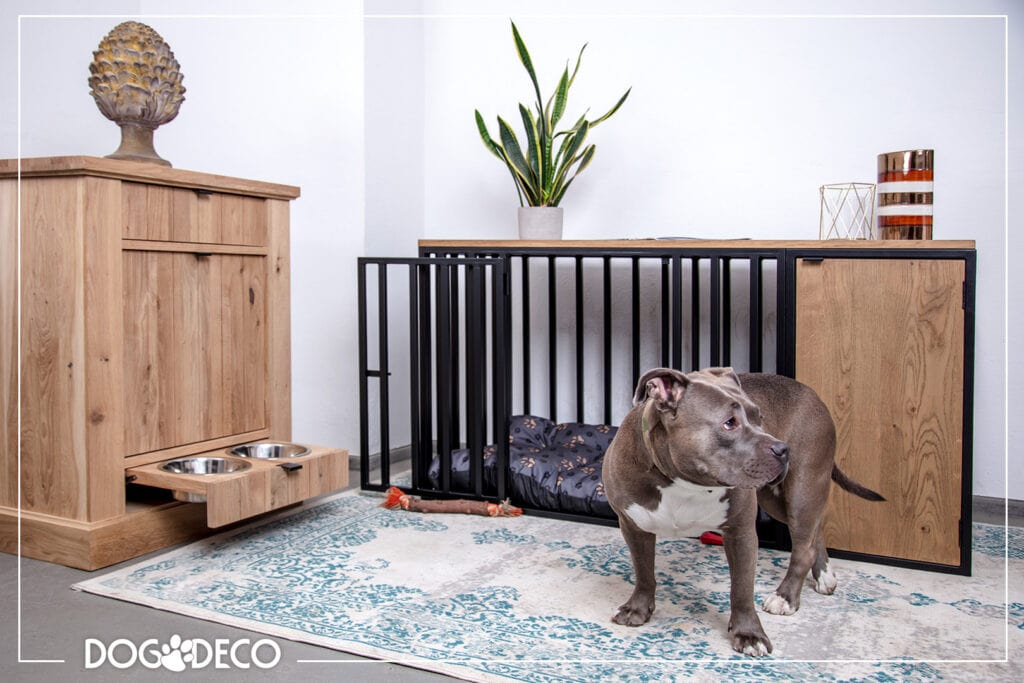Dog crate myths and facts
- July 11, 2022
- 1:56 pm
The dog crate has divided many four-legged friends into two opposing camps. The former, staunch opponents of kennels, say that keeping loved ones isolated is barbaric, while the latter point to the tremendous benefits of using dog crates for both household members and pets. Today, let’s take a look at the pros and cons of dog crate furniture and see what they can offer, how they can help, and when they can cause unwanted reactions.
Dog crate myths and facts – pros and cons of a dog crate
We all know that life doesn’t always look perfect with a dog by your side. The part of dog owners that deals with and works on behavioral problems has probably already come across the term box for dogs. The users of the cage furniture appreciate their advantages and help with socialization, silencing, coming to terms with bad habits, trauma or, for example, frequent separation anxiety in dogs. The remaining part, which does not have major problems raising the species Canis familiaris , just as often takes advantage of the advantages that dog cages offer, knowing that by using this tool they will contribute to a fuller development of their pet and will give them satisfaction Basic needs.
Among the opponents of kennel cages, the opinion is often expressed that wooden or metal dog crates are used as a piece of furniture to constantly restrict, abuse and punish freedom. Kennels cages are often associated with the sight of animals peeking out from behind bars, such as in a zoo. This stereotypical thinking of dog cages as pseudo-pet prisons is very damaging. On the other hand, such comparisons are hardly surprising, because in both cases we are dealing with a form of isolating the animal from some part of the room, but the idea, purpose and effect of using a piece of furniture for a dog are completely different.
Dog Cage Myths:
- It is used to punish the dog for undesirable behavior, for example.
- A four-legged friend in a cage suffers.
- It causes discomfort to the animal.
- Increases your dog’s separation anxiety.
- It increases aggression and disobedience.
- Only young specimens can get used to the kennel crate.
- It’s unsightly and takes up a lot of space.
All of these popular opinions about dog kennels crates are often the result of ignorance or ignorance of the dog’s psyche. On the other hand, when we improperly implement the dog crate into our pet’s life, the myths described above turn out to be true.
Before buying, pay attention to the material used for manufacture, workmanship, suitable dimensions, the place where you will place the cage and arm yourself with knowledge of customization techniques. It is worth looking for information on what type of cage is perfect for your dog (ask the manufacturer for advice, see the opinions of other cage users). Look for the right model and size that will guarantee you a sense of security and comfort.
In most cases that we know of, the introduction of a dog crate goes very smoothly, and the dogs quickly understand what the whole “dog crate” is all about.
The entry techniques are also very easy to learn, just follow a few basic rules.
Dog Crate Facts:
- A great tool to help you fight separation anxiety.
- Perfect for learning the recall command “to the seat”, for example when visiting guests.
- It speeds up the learning process of grooming by harnessing the dog’s natural instinct that doesn’t take care of its physiological needs in the den.
- It prevents damage to the property of the owner.
- It facilitates the introduction of, for example, a transporter while driving. A dog that lives in a dog cage at home will relax more quickly in a holdall when traveling by train or car.
- It protects the four-legged friend after veterinary interventions and e.g. B. during convalescence to limit physical activity.
- With a few pets at home, it isolates a bitch in heat from men.
- It’s a safe haven for a new mother dog and her offspring.
- It serves as a temporary place of isolation and shelter in special circumstances such as renovation, use of products that the dog should not come into contact with, noises to which it reacts badly (e.g. ).
- It strengthens the sense of security and self-confidence.
- It teaches how to rest and relax.
- Provides a quiet place to sleep. Remember that a healthy dog should sleep 14 hours a day.
- The perfect place to relax while your dog is excited.
- Properly selected, it will be an interesting accent that will complement the stylization of our interior.
Dog crate myths and facts – we hope this post has explained the principle of dog crates and the impact we can expect from the introduction of this tool.
Why will your dog appreciate the benefits of a dog crate?
Dogs naturally seek shelter in cramped, isolated, and mostly shady places and choose them as their resting spots or hiding spots. A dog crate is an ideal extension of what is available in nature, so dogs immediately understand what they are there for and enjoy being in it. Dog crate furniture guarantees satisfaction of basic “dog” needs. It allows you to rest effectively while controlling the environment. Remember that a relaxed, rested, secure, and calm dog is a happy dog.
#Dog blog



